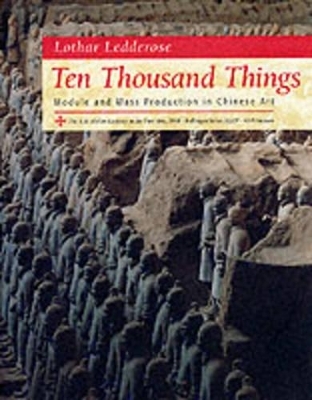
Ten Thousand Things
Princeton University Press (Verlag)
978-0-691-00957-5 (ISBN)
- Titel ist leider vergriffen;
keine Neuauflage - Artikel merken
Chinese workers in the third century b.c. created seven thousand life-sized terracotta soldiers to guard the tomb of the First Emperor. In the eleventh century a.d., Chinese builders constructed a pagoda from as many as thirty thousand separately carved wooden pieces. In the seventeenth and eighteenth centuries, China exported more than a hundred million pieces of porcelain to the West. As these examples show, the Chinese throughout history have produced works of art in astonishing quantities--and have done so without sacrificing quality, affordability, or speed of manufacture. How have they managed this? Lothar Ledderose takes us on a remarkable tour of Chinese art and culture to explain how artists used complex systems of mass production to assemble extraordinary objects from standardized parts or modules. As he reveals, these systems have deep roots in Chinese thought--in the idea that the universe consists of ten thousand categories of things, for example--and reflect characteristically Chinese modes of social organization.
Ledderose begins with the modular system par excellence: Chinese script, an ancient system of fifty thousand characters produced from a repertoire of only about two hundred components. He shows how Chinese artists used related modular systems to create ritual bronzes, to produce the First Emperor's terracotta army, and to develop the world's first printing systems. He explores the dazzling variety of lacquerware and porcelain that the West found so seductive, and examines how works as diverse as imperial palaces and paintings of hell relied on elegant variation of standardized components. Ledderose explains that Chinese artists, unlike their Western counterparts, did not seek to reproduce individual objects of nature faithfully, but sought instead to mimic nature's ability to produce limitless numbers of objects. He shows as well how modular patterns of thought run through Chinese ideas about personal freedom, China's culture of bureaucracy, Chinese religion, and even the organization of Chinese restaurants.
Originally presented as a series of Mellon lectures at the National Gallery of Art, Ten Thousand Things combines keen aesthetic and cultural insights with a rich variety of illustrations to make a profound new statement about Chinese art and society.
Lothar Ledderose holds the chair of East Asian Art at the University of Heidelberg. He is an internationally renowned scholar of Chinese art and calligraphy. He has curated numerous exhibitions on Asian art including Treasures from the Forbidden City (Berlin, Vienna, 1985), The Terracotta Army (Dortmund 1991), Japan and Europe (Berlin 1993), and an exhibition of Chinese painting of the Ming and Qing dynasties (Baden-Baden 1985). His books include Mt Fu and the Classical Tradition of Chinese Colligraphy (Princeton) and Felsen and Orchideen.
Acknowledgments vi Introduction 1 1 The System of Script 9 2 Casting Bronze the Complicated Way 25 3 A Magic Army for the Emperor 51 4 Factory Art 75 5 Building Blocks, Brackets, and Beams 103 6 The Word in Print 139 7 The Bureaucracy of Hell 163 8 Freedom of the Brush? 187 Notes 215 Bibliography 229 Glossary of Chinese Terms 252 Index 256 Picture Sources 264
| Erscheint lt. Verlag | 22.7.2001 |
|---|---|
| Reihe/Serie | Bollingen Series |
| Zusatzinfo | 16 color plates. 325 b/w illus. |
| Verlagsort | New Jersey |
| Sprache | englisch |
| Maße | 216 x 279 mm |
| Gewicht | 1134 g |
| Themenwelt | Kunst / Musik / Theater ► Kunstgeschichte / Kunststile |
| Sozialwissenschaften | |
| ISBN-10 | 0-691-00957-0 / 0691009570 |
| ISBN-13 | 978-0-691-00957-5 / 9780691009575 |
| Zustand | Neuware |
| Haben Sie eine Frage zum Produkt? |
aus dem Bereich


